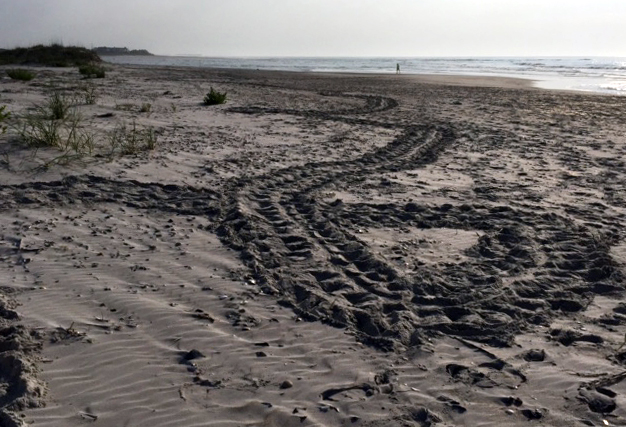North Carolina’s sea turtle nesting season, which started in May, is already more active than normal locally, with three loggerhead nests and four false crawls discovered on Wrightsville Beach. The number of nests might have been higher, but the actions of several beachgoers could have deterred one turtle from nesting recently.
The town’s police officers were patrolling the beach at night last week when they observed several people taking photographs of a turtle near Public Beach Access No. 20, said Nancy Fahey, project coordinator for the Wrightsville Beach Sea Turtle Project. The officers told the people to back away from the turtle, but Fahey said the turtle did not nest that night.
“[Taking photos] of the turtle can scare her back into the water and cause her to abandon her attempt to nest,” Fahey said, “so it’s really important for people to respect the turtle, keep their distance and remain quiet.”
Beachgoers should never approach turtles on the beach, she added, especially since turtles’ vision on land is not strong. Fahey recommended that anyone who comes across turtle activity on Wrightsville Beach should call her at 910-612-3047 and turtle activity on other beaches should be reported to the sea turtle hotline at 252-241-7367.
Fahey said she’s very grateful to the beach officers, who “have made a great effort to stay on top of the situation with the turtles on the beach this year and communicate with us. I think we’ve seen a greater chance of success when we all collaborate.”
Turtles that crawl up the beach and don’t nest create what’s known as a false crawl, Fahey said. It’s a fairly common occurrence, she added — so far this year along North Carolina’s coastline there have been 143 false crawls and 121 loggerhead nests found. That ratio of false crawls to nests is normal, she said, but the number of both is higher than average.
“It seems promising that we’re going to have a busy summer,” she said.
Wrightsville Beach Sea Turtle Project volunteers walk the beach every morning, looking for both nests and false crawls. When they find a nest, they rope it off so beachgoers don’t disturb it. In about 60 days, Fahey said, volunteers will start monitoring the nests for signs of hatching. That’s the typical incubation period, Fahey said, but it could be a little bit longer, depending on the weather.
“The cooler the weather, the longer it takes them,” she said. “So early-season nests will incubate a little bit longer.”
email [email protected]




